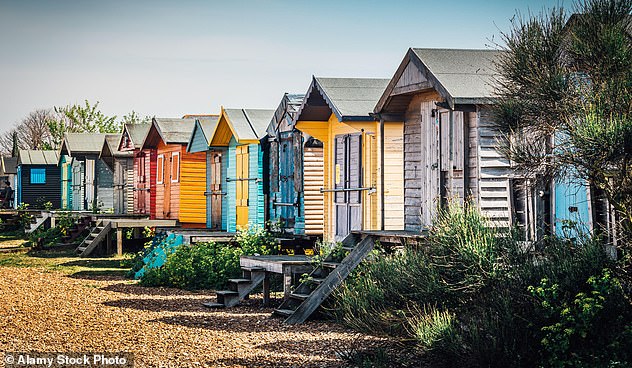Oyster farm tour manager Renny Hall holds a 650g jumbo oyster shell in the Whitstable Oyster Company grading shed.
“I barbecued an oyster this size over the weekend and put it in a bun with pickles,” he says.
Oysters, as you quickly learn on a Whitstable oyster tour, can be enjoyed in many ways: au naturel, tempura-battered or quarter-pounder style.
This Kentish seaside town has been famous for them for at least 2,000 years (Roman texts mention Whitstable as an excellent source), but farming was not regulated until 1793.
At the peak of production in 1860, it is estimated that 150 small vessels supplied London’s Billingsgate market with 80 million units.
A cheerful picture: Kate Wickers explores Whitstable, a seaside town in Kent known for its brightly painted beach huts (pictured)

Above, the pebble beach at Tankerton, a suburb of Whitstable
Today, the Whitstable Oyster Company harvests between 3 and 4 million oysters a year and during July, August and September an impressive 35,000 are consumed per week, even more during the annual oyster festival, which starts next Friday.
At low tide I walk in wellies along the Grade II-listed jetty off Horsebridge Road, named after the horses that once pulled carts from the oyster beds.
Here, Renny shows me the metal baskets where the oysters are grown.

Whitstable has been famous for its oysters for at least 2,000 years, reveals Kate
Looking towards the town, you get a good view of the colourful rows of 150-year-old fishermen’s cottages (converted into holiday homes) and cottages.
A gleaming mound of oyster shells covers the beach beside the Royal Native Oyster Stores restaurant, from where they are wheeled away to return to the wild. Later, at this Victorian oyster warehouse, I eat half a dozen, dressed with lemon and a splash of shallot vinegar: they are delicious. The tip is to chew them twice to release all the briny flavour.
It takes an hour to walk from the striped beach huts of the suburb of Tankerton to those of Seasalter, detouring to the harbour, where fishing boats bob alongside The Chieftan, a vintage lifeboat offering trips around the bay. Next to the quay is the Harbour Market, made up of stalls displaying the work of local painters, jewellers and potters. Stalls also sell snails, crabs and oysters.

During July, August and September, an impressive 35,000 oysters are consumed in Whitstable every week (above)

Kate enjoys a drink at the Old Neptune (seen above), the oldest pub in the city, dating back to the early 19th century.

Above, one of the city’s oyster bars.
Among the collage of attractive shop fronts on Harbour Street and High Street, the prettiest is the pink-painted Wheelers. Here you can buy picnic baskets filled with delicacies such as crab and prawn tartlets and seafood arancini.
Back on the coast, at high tide, I sit down to a Whitstable Harbour gin, flavoured with sea buckthorn and sea fennel, in the town’s oldest pub, the Old Neptune, which dates back to the early 19th century.
With the seas rising, all that is now visible of the oyster beds are the yellow buoys and poles that mark them, their presence as constant as the ebb and flow of the tide.


